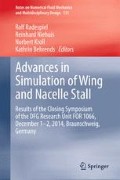Abstract
In this paper we present two different methods to provide turbulence data for aircraft design studies. The first method is based on the discrete gust approach which describes one single gust event as analytical approximation. Based on mean gust shape calculations in turbulent wind fields obtained from high-resolution large-eddy simulations (LES), we suggest both a new one- and two-dimensional gust shape model. The one-dimensional gust shapes differ significantly from the classical one-minus-cosine gust. Two-dimensional mean gust shapes show elliptically shaped contours with varying aspect ratios for different gust diameters.
The second and more complex method provides three-dimensional turbulent wind speed data from LES. This approach allows to consider explicitly the influence of buildings on aircraft during take off or landing. In order to quantify the influence of an idealized airport building on aircraft, a virtual crosswind landing trough the wake of a building was simulated within the LES data. Following the 7-knots-criterion, the building induced flow disturbances may have a significant influence on landing aircraft. Both methods will be used in future to initialize a computational fluid dynamics (CFD) model to simulate the flow around an aircraft.
Access this chapter
Tax calculation will be finalised at checkout
Purchases are for personal use only
Preview
Unable to display preview. Download preview PDF.
References
Anon.: “Federal Aviation Regulations - Part 25 - Airworthiness Standards: Transport Category Airplanes". Department of Transportation, Federal Aviation Administration, Washington, DC (2012)
Anon.: “International standards and recommended practices", AERODROMES ANNEX 14, Volume 1 aerodrome design and operations, Chapter 4: Obstacle restriction and removal (1995)
Blocken, B., Carmeliet, J.: Pedestrian Wind Environment around Buildings: Literature Review and Practical Examples. Journal of Thermal Env. and Bldg. Sci., 28(2) 107–159 (2004)
Camp, D.W.: Wind velocity measurements of low level wind gust amplitude and duration and statistical gust shape characteristics. National Aeronautics and Space Administration, Technical Memorandum (1968)
Deardoff, J.W.: Stratocumulus-topped mixed layers derived from a three-dimensional model. Bound.-Layer Meteor., 18, 495–527 (1980)
Frost, W., Long, B.H., Turner, R.E.: Engineering Handbook on the Atmospheric Environmental Guidelines for Use in Wind Turbine Generator Development. National Aeronautics and Space Administration, Technical Paper 1359 (1978)
Hau, E.: Wind turbines. 2nd edn. Springer, Heidelberg. 783. p, (2006)
Hoblit, M.: Gust Loads on Aircraft: Concepts and application. American Insitute of Aeronautics and Astronautics, Washington D.C (1988)
Kelleners, P., Heinrich, R.: Accurate simulation of interaction of airfoils and aircraft with atmospheric gust and turbulence. In: Fourth Joint Symposium of DFG FOR 1066 and DLR-Airbus CASE: Simulation of Wing and Nacelle Stall. Braunschweig, Germany (2014)
Knigge, C., Auerswald, T., Raasch, S., Bange, J.: Comparison of two methods simulating highly resolved atmospheric turbulence data for study of stall effects. Computers and Fluids 108, 57–66 (2015)
Knigge, C., Raasch, S.: Improvement and development of one- and two-dimensional discrete gust models using a large-eddy simulation model. Submitted to Journal of Wind Engineering and Industrial Aerodynamics (2014)
Kristensen, M., Casanova, M.S., Troen, I.: In search of a gust definition. Boundary-Layer Meteorol. 55, 91–107 (1991)
Krüs, H.W., Haanstrab, J.O., van der Hama, R. Wichers Schreurc, B.: Numerical simulations of wind measurements at Amsterdam Airport Schiphol. Journal of Wind Engineering and Industrial Aerodynamics 91, 1215–1223 (2003)
Nieuwpoort, A.M.H., Gooden, J.H.M., de Prins, J.L.: Wind criteria due to obstacles at and around airports, NLR-CR-2006-261, National Aerospace Laboratory (2006)
Pratt, K.G., Walker, W.G.: A Revised Gust-Load Formula and A Re-Evaluation of V-G Data Taken on Civil Transport Airplanes From 1933 to 1950. NACA TR-1206 (1954)
Raasch, S., Schröter, M.: PALM - A large-eddy simulation model performing on massively parallel computers. Meteorol. Z. 10, 363–372 (2001)
Schwamborn, D., Gerhold, T., Heinrich, R.: The DLR TAU-Code: recent applications in research and industry. In: Proceedings of European Conference on Computational Fluid Dynamics ECCOMAS CDF 2006, TU Delft, The Netherland (2006)
Sleeper, K.S.: Spanwise Measurements of Vertical Components of Atmospheric Turbulence. National Aeronautics and Space Administration, Technical Paper 2963 (1990)
Stull, R.B.: An introduction to boundary layer meteorology. Kluver Academic Publishers, 666, p. (1988)
Verheij, F.J., Cleijne, J.W., Leene, J.A.: Gust modelling for wind loading. J. Wind Eng. Ind. Aerodyn. 42, 947–958 (1992)
Author information
Authors and Affiliations
Corresponding author
Editor information
Editors and Affiliations
Rights and permissions
Copyright information
© 2016 Springer International Publishing Switzerland
About this paper
Cite this paper
Knigge, C., Raasch, S. (2016). Development and Improvement of Two Methods of Different Complexity to Simulate Atmospheric Boundary Layer Turbulence for Aircraft Design Studies. In: Radespiel, R., Niehuis, R., Kroll, N., Behrends, K. (eds) Advances in Simulation of Wing and Nacelle Stall. FOR 1066 2014. Notes on Numerical Fluid Mechanics and Multidisciplinary Design, vol 131. Springer, Cham. https://doi.org/10.1007/978-3-319-21127-5_11
Download citation
DOI: https://doi.org/10.1007/978-3-319-21127-5_11
Published:
Publisher Name: Springer, Cham
Print ISBN: 978-3-319-21126-8
Online ISBN: 978-3-319-21127-5
eBook Packages: EngineeringEngineering (R0)

